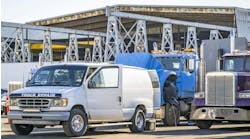The shipping industry has 63,000 fewer drivers than it needs, according to the American Trucking Associations. That number is expected to rise to 176,000 by 2026. With 71% of U.S. freight being transported via trucks, the shortage could cause slower shipments and higher prices for both consumers and operators, while simultaneously undermining the increasingly delivery-dependent economy.
Carriers struggle to recruit and retain new drivers. Burnout is common due to the arduous nature of trucking, requiring drivers to sacrifice time with friends and family for long-hauls and lengthy trips. The current annualized turnover rate sits at an astronomical 94%, higher than almost every other industry. Based on the turnover rate, the drivers that do stick with the job should be in for constant work and large paydays, but federal safety regulations on drive time cap potential earnings, decreasing the incentive to stick with the profession.
Carriers are looking to new technology like autonomous trucks to combat the shortage, but self-driving vehicles come with hefty price tags, unproven hardware, and distant timelines. Fortunately, recent innovations in blockchain technology could help compensate for the critical driver shortage.
Blockchain tech has the potential create a more efficient trucking industry by streamlining logistics. Blockchain helps maximizes fuel usage, optimizes routes, and ensures automatic, instantaneous payments, while logging immutable records of everything from freight condition to drive times. Smart contracts facilitated via blockchain allow shippers and carriers to eliminate the need for brokerage firms, who act as middlemen, and often take up to 30% to handle transactions.
By creating a more efficient trucking industry, LaneAxis is hoping to drastically improve the driver experience, using blockchain to increase their revenues and cut costs, while protecting carriers by providing detailed records. Drivers are often compensated based on productivity, meaning efficiency is key to ensuring the highest possible payday for drivers. Constantly updated routes mean quicker deliveries and decreased fuel costs. Instantaneous new load acquisition and driver verification mean less empty trucks on the road and greater productivity. Immutable records can provide legal protection and quality assurance for both carriers and shippers.
Blockchain tech has the power to ease the strain of the truck driver shortage and reward drivers for their hard work by improving the efficiency of the trucking industry and putting more money in the pockets of the professionals that provide the backbone for American commerce. No one solution will remedy the increased demand for drivers, and with autonomous trucks still years away from being implemented on a large scale, blockchain offers an immediate outlet to help make up for the lack of drivers.



